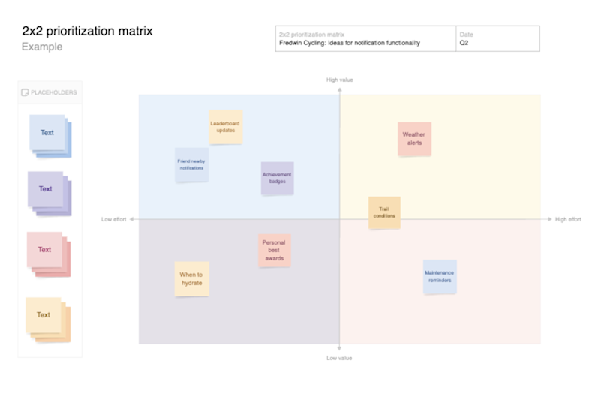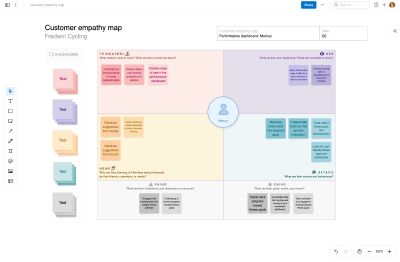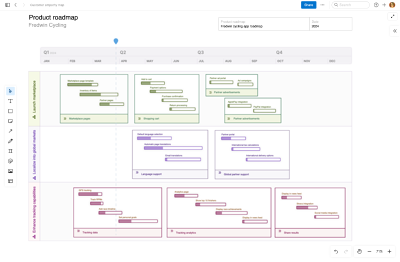What is a customer journey map?
Last updated: March 2024
A customer journey map is a representation of all the ways customers interact with your company or product throughout the buyer journey. It visualizes touchpoints across stages — from first becoming aware of your offering through to purchase and (ideally) loyalty. Customer journey maps typically align each interaction to what the customer is doing, thinking, and feeling along the way. By viewing the journey from the customer's perspective, you can broaden your empathy of their overall experience and improve it.
Collaborate on a customer journey map in Aha! software. Sign up for a free trial.
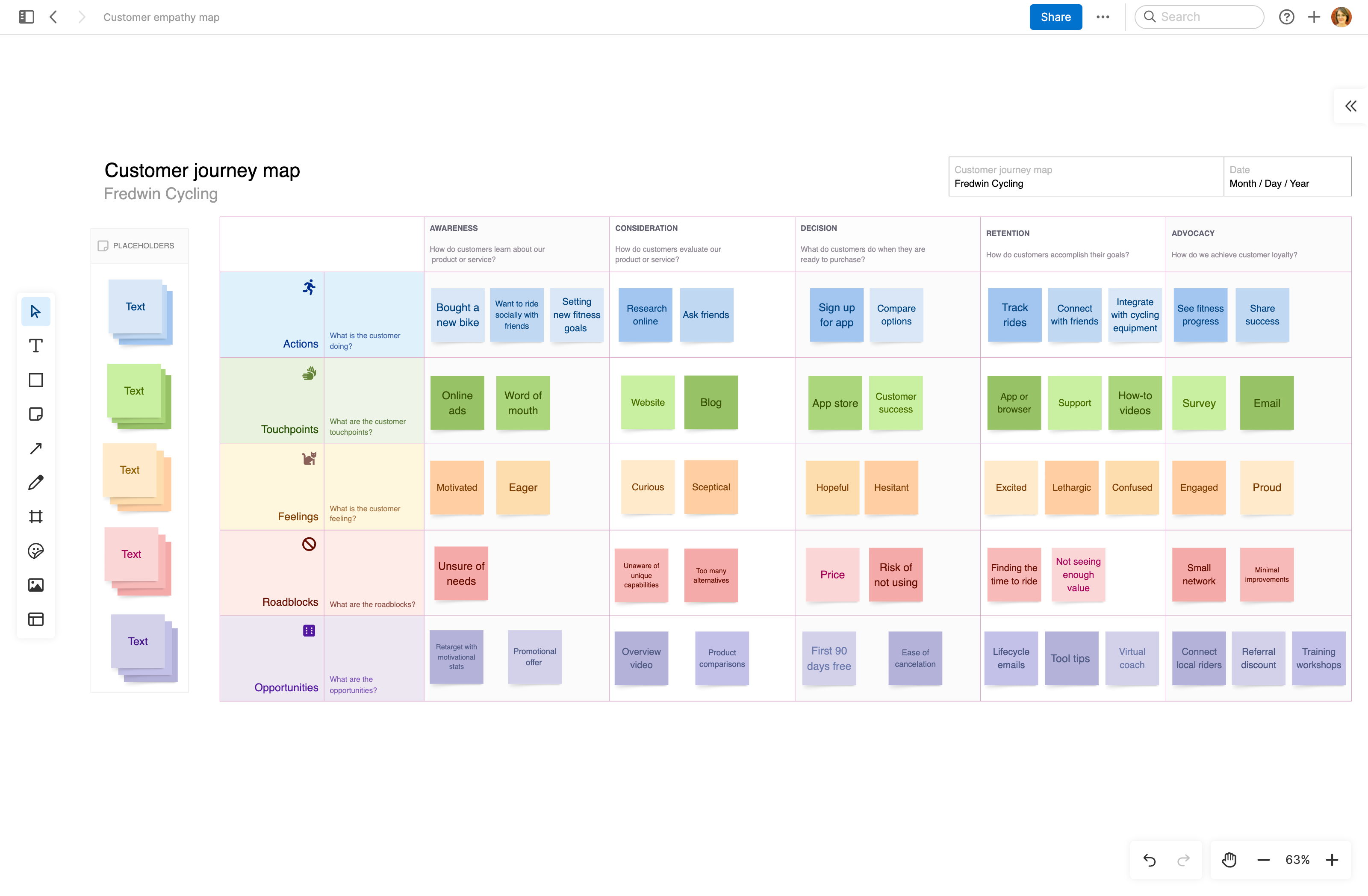
The goal of customer journey mapping is to identify ways to make the buying process and the Complete Product Experience (CPE) more seamless and engaging. That means examining everything from trial signups to product renewals and all the interactions in between — looking for points of friction or frustration the customer may be experiencing. Where do folks disengage or drop off? How can your marketing, sales, and service teams better understand and provide what customers need at each stage? Building and taking action on a customer journey map requires that you tap into collective knowledge — bringing together representatives from product management, marketing, sales, and support.
In reality, customer journey mapping is only becoming more complex. Customers typically need to become problem-aware before they are even aware of your product. And as they move from awareness to consideration and decision-making, they are influenced by external factors (e.g., review sites, word of mouth, and competitors) as well as interactions with your company (e.g., digital ads, content, product demos, and live chat). Collecting meaningful data on customers' online and offline behavior is challenging — particularly because customer journeys vary by persona and even individual. Oftentimes, customers take a start-stop, cyclical journey that is dictated by their own goals, whims, and budgets.
So, why build a customer journey map if it is all so hard to pin down? The purpose is not perfection. Rather, you are aiming to define as typical a journey as you can, so you can build a more cohesive brand experience. Your map can spark conversations across teams about where to invest time, resources, and effort.
Jump ahead to any section to explore more:
Why is customer journey mapping important?
Customer behavior can be mysterious. Some people may spend meaningful time exploring your product during a free trial — then never sign up. Others might hear about you from a friend and purchase based on that recommendation alone. Try not to let every edge case overwhelm you. The purpose of journey mapping is to capture a high-level view of touchpoints across channels — think generally rather than specifically.
This is not to say that you will not uncover deep insights. Outlining buyer stages, actions, and feelings can illuminate gaps in the buyer experience that hinder progress.
Let's look at an example. In the screenshot below, we are zeroing in on the consideration stage for a fictitious fitness-tracking app for cyclists. We know that prospective customers are curious to find out which features we offer against other apps on the market — they are exploring review sites and trial signups are high. Yet, trial engagement for the features they care about is low.
Of course, there could be various reasons for this. We might hypothesize that customers do not know where to start in our app or are having trouble finding what they need. There may be an opportunity to ease customer confusion with a "Getting started" video at initial login or a guided onboarding experience.
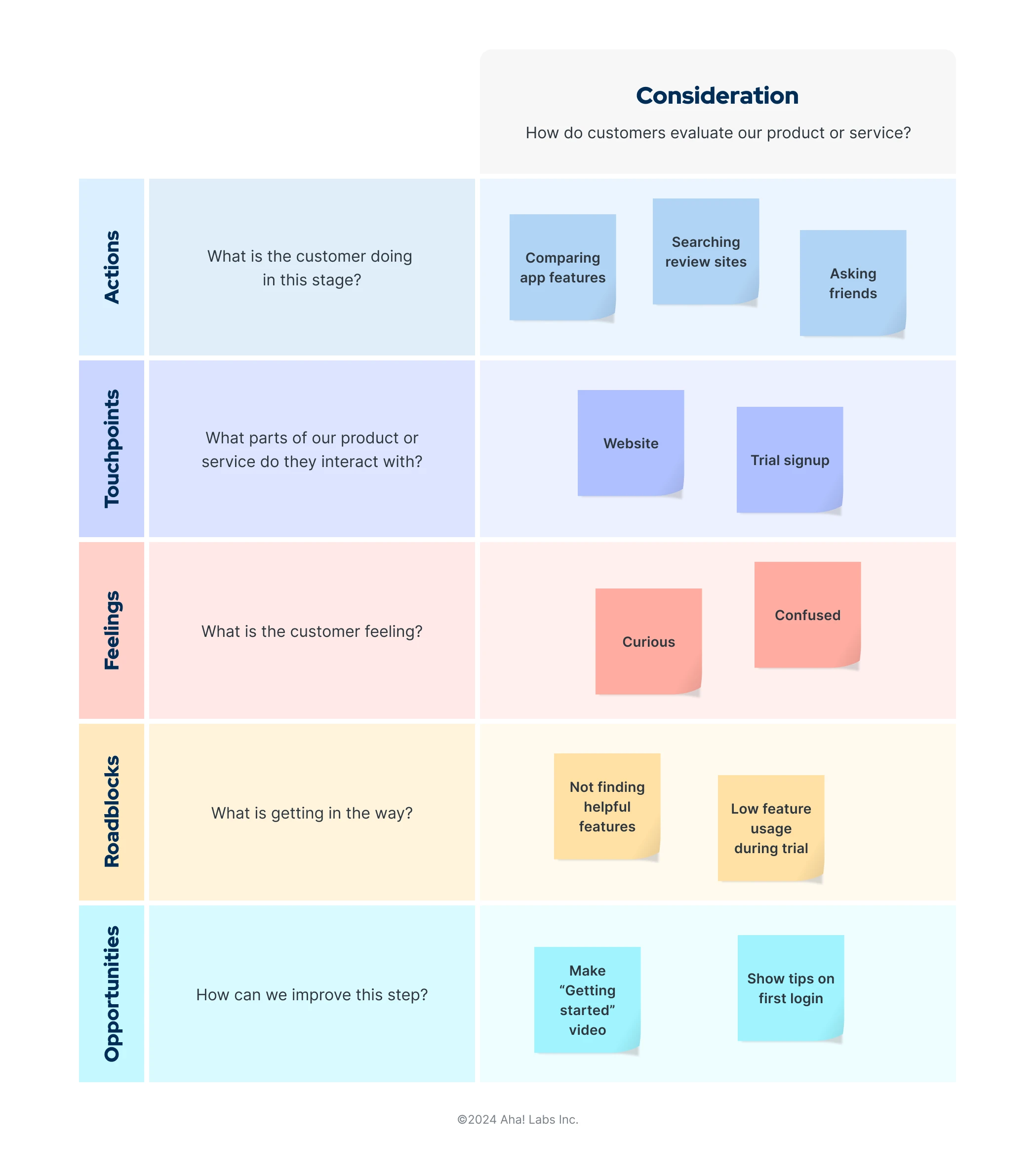
Components of a customer journey map
The components of your journey map will depend on what your company or team need. Typically, the customer journey is mapped from left to right with stages mapped horizontally and key touchpoints, customer reactions, and opportunities mapped vertically.
Below is a typical list of what you will find on a customer journey map and what to consider for each element:
Customer journey stages | What to consider |
Awareness | How do customers learn about our product or service? |
Consideration | How do customers evaluate our product or service? |
Decision | What do customers do when they are ready to purchase? |
Retention | How do customers accomplish their goals with our product or service? |
Advocacy | How do we achieve customer loyalty? |
Discussion points | What to consider |
Actions | What is the customer doing in this stage? |
Touchpoints | What parts of our product, service, or company do they interact with? |
Feelings | What is the customer feeling at this stage? |
Roadblocks | What is getting in the way of customers moving to the next stage? |
Opportunities | How can we improve this step and remove roadblocks? |
Related: Understanding the buyer's journey
Customer journey maps vs. user journey maps
As a product builder, you are probably familiar with user journey mapping — also called a user flow. Both customer journey maps and user journey maps are helpful for product development and center on the customer's perspective. But each has a distinct purpose — along with varying components and ownership.
At a basic level, a customer journey map covers touchpoints across the entire customer experience, while a user journey map narrows in on how a user moves through your product.
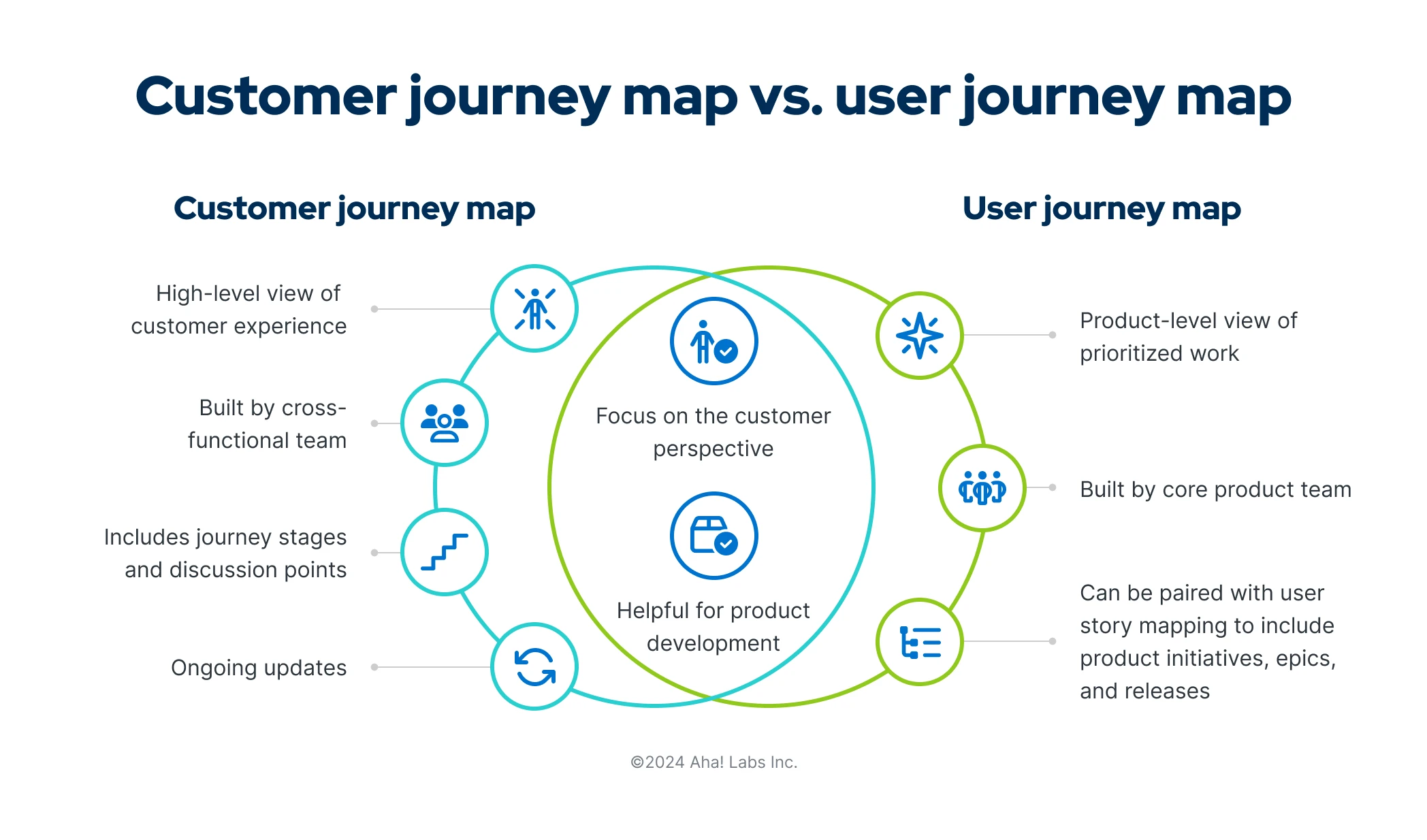
Understanding these key differences will help you know when to rely on each one:
Customer journey map | User journey map | |
Purpose | Provides a high-level view of the entire customer journey and touchpoints throughout — highlighting ways to improve the entire CPE | Provides a product-level view of a user's flow through a discrete area of your product, such as a checkout flow or onboarding flow |
Components |
|
|
Owner | Broad cross-functional product development team including product management, marketing, sales, and support | Core product team including product management, UX, and engineering |
Timing | Ongoing | Can be ongoing or during release planning |
While customer journey maps and user journey maps have different use cases, the two can work together to drive alignment on the problems you want to solve. For example, your customer journey map may highlight that customers drop off during self-serve account creation. You could carry this observation over to user journey mapping — as a proof point for prioritizing functionality to simplify the signup process.
It is worth noting that your organization may use different terminology. Stick with what works for you — it is more important to align on purpose and process than semantics.
Related:
How to create a customer journey map
Let's jump in. You are ready to build a customer journey map and rally stakeholders across teams. With some upfront planning, you can make sure it is a valuable use of everyone's time — generating healthy debate and experimentation.
Follow these steps to get started:
1. Set your objectives
Goals matter — especially when bringing together cross-functional teammates who have their own OKRs. Consider what you want to collectively achieve and how you will measure outcomes. Think in terms of customer value and growth, rather than merely conversion.
2. Choose a customer persona
Focus on a particular customer persona or user type and tailor the exercise to them. If you build multiple maps, start with your most common persona.
3. Conduct initial customer research
You cannot guess what your customers are thinking or feeling. Do some research to gain insight on your customers' perspectives. Dig into what your team has heard in recent customer conversations or, even better, do some outreach of your own to learn about their goals, wants, and needs.
4. Set up a way to collaborate
Cross-functional input is the only way to get a fully nuanced view of customer interactions. When building your customer journey map, invite representatives to a working meeting or a shared whiteboard so they can offer their insights.
5. Start mapping
Mapping is a multi-day process. Take your time as you gather inputs.
Starting with Actions, discuss this point for each stage of the customer journey.
Working row-by-row, fill out Actions for all stages before moving onto Touchpoints.
Use sticky notes to capture ideas in each section.
When you get to Roadblocks, pause to discuss before moving onto Opportunities.
Vote on the best Opportunities to move forward with.
6. Make a plan
Your customer journey map is just the beginning. Consider how will you address the problems and opportunities you uncover. Compare the ideas you identified with existing items in your backlog. Discuss ways to augment or adjust your plans for upcoming program or product enhancements to incorporate findings from customer journey mapping.
7. Revisit and update
As your company and teams evolve, so will your customer journey. Revisit the customer journey map and create new ones to spark ideas for future innovation.
At first, customer journey mapping might feel largely like guesswork, especially if you have minimal customer data to learn from. But starting somewhere is better than nowhere. A customer journey map is not a static document — iterate and improve on it as you grow.
